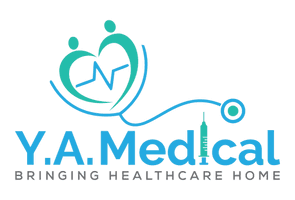Telenursing is revolutionizing the way healthcare is delivered to homebound patients. By leveraging technology, telenursing bridges the gap between patients and healthcare providers, ensuring timely and efficient care. Here are 11 key benefits of telenursing for home health patients.
1. Improved Access to Healthcare
Telenursing has brought about a profound transformation in providing healthcare for patients residing in remote or underserved areas. These patients often face significant barriers to accessing adequate healthcare services, such as long distances to medical facilities, limited availability of healthcare providers, or poor transportation infrastructure. With the advent of telenursing, these challenges are significantly reduced or entirely eliminated. Through video conferencing, phone consultations, and online communication platforms, patients can easily connect with qualified healthcare professionals from the comfort of their own homes.
This convenient access to care ensures that patients receive timely assessments, medical advice, and follow-ups without the need to undertake time-consuming or physically demanding travel. Additionally, telenursing ensures that individuals in rural communities, where specialty healthcare providers may not be readily available, can still receive expert opinions and personalized treatment plans. It also addresses disparities in healthcare access by allowing family members or caregivers to participate in medical consultations remotely, fostering a collaborative approach to care.
Beyond geographical barriers, telenursing enhances accessibility for patients with mobility issues, disabilities, or chronic illnesses that make traveling to a clinic or hospital particularly challenging. This virtual healthcare model not only increases the reach of home health services but also reduces the financial burden associated with travel, including transportation costs and lost income due to time away from work. For patients who once lacked access to essential care, telenursing is a lifeline that ensures equitable and consistent healthcare delivery across diverse populations.
2. Continuous Remote Monitoring
Effective management of chronic conditions relies heavily on consistent oversight and the early detection of potential complications. Telenursing excels in this area by enabling continuous remote monitoring of patients’ health status through an array of technological tools and devices. Wearable devices, such as smartwatches and fitness trackers, allow healthcare providers to monitor vital signs such as heart rate, blood pressure, oxygen levels, and blood glucose levels in real time. This constant stream of data equips nurses with the information they need to make timely and informed decisions about patient care.
Remote monitoring also offers significant benefits for patients managing conditions like diabetes, hypertension, heart disease, and chronic obstructive pulmonary disease (COPD). Instead of relying solely on periodic in-person check-ups, patients’ health can now be tracked on a daily basis. This reduces the risk of sudden health crises, as warning signs can be detected early and appropriate interventions can be implemented promptly. For example, if a telenurse notices a consistent rise in a patient’s blood pressure readings over a span of days, they can intervene before the situation escalates into a medical emergency, potentially preventing hospital visits or serious complications.
Furthermore, remote monitoring establishes a sense of partnership and accountability between patients and their healthcare providers. Patients are encouraged to take an active role in managing their health, while nurses provide close guidance and support. This not only boosts patient outcomes but also fosters long-term adherence to treatment plans.
On a broader scale, continuous remote monitoring helps alleviate the burden on healthcare facilities by reducing the frequency of hospital readmissions. As healthcare systems strive to manage growing patient populations with limited resources, technologies that promote preventive care and early intervention are becoming increasingly valuable. For homebound patients or those recovering from surgery, telenursing’s monitoring capabilities offer peace of mind, knowing that their condition is being closely observed even when they are outside the direct care environment.
Through its ability to track health data continuously and ensure timely responses, telenursing supports safer, more efficient, and highly personalized care for patients dealing with chronic and long-term illnesses. It represents a significant step forward in proactive disease management, bridging the gap between patients and vital Home healthcare services.
3. Personalized Care Plans
Every patient has unique health needs that require careful consideration and a tailored approach. With telenursing, healthcare providers can design highly customized care plans that address these individual requirements. By utilizing detailed patient data gathered through remote monitoring devices, wearable technology, or virtual check-ins, nurses can develop comprehensive care strategies that focus on the specific health challenges and goals of each patient.
For example, patients managing chronic conditions, such as diabetes or heart disease, benefit from care plans that integrate diet recommendations, physical activity guidelines, and timely medical interventions. Telenursing ensures that these plans are not only personalized but also adaptable to the patient’s evolving health situation, whether that means adjusting medications, monitoring symptoms more closely, or responding quickly to any new signs of concern. This level of customization helps patients feel supported and understood, ultimately improving their overall health outcomes and quality of life.
Additionally, the digital interface of telenursing allows for quicker adjustments to care plans. Unlike traditional approaches where updates may require in-person visits, telenursing streamlines communication, enabling real-time updates based on daily health reports. This fosters a proactive approach to healthcare, preventing complications before they arise and increasing the effectiveness of treatment. By designing care plans that are as unique as the patients themselves, telenursing empowers individuals to take an active role in managing their health while ensuring they have professional support at every step.
4. Reduced Healthcare Costs
Cost efficiency is a critical factor in healthcare, and telenursing significantly reduces medical expenses while maintaining quality care. By minimizing the need for frequent in-person visits, emergency room trips, and prolonged hospital stays, telenursing provides a financially viable solution for both healthcare systems and patients. For individuals managing chronic illnesses, regular remote monitoring reduces the likelihood of severe complications that can lead to costly medical interventions or hospitalizations.
Through virtual consultations and digital check-ins, patients can connect with their healthcare providers without incurring transportation costs or taking extended time off work. This accessibility relieves some of the financial burden on families while still ensuring that health concerns are addressed promptly. Healthcare facilities also benefit by allocating resources more efficiently; fewer in-person visits mean more attention can be directed toward patients requiring urgent, hands-on care.
Government-funded and private health insurance programs increasingly recognize the value of telenursing as a cost-saving tool that reduces the strain on healthcare infrastructure. For instance, preventive measures made possible through telenursing—such as early detection of symptoms or tailored health education—help avoid expensive treatments for advanced illnesses. By creating an ecosystem that prioritizes accessible and affordable healthcare, telenursing enables patients to achieve better outcomes without overwhelming financial pressures.
5. Enhanced Medication Management
Proper medication adherence is a critical component of effective healthcare, yet missed doses and medication errors remain a widespread challenge. Telenursing provides innovative solutions to enhance medication management, ensuring patients follow prescription protocols correctly and consistently. Using digital platforms, patients receive timely reminders about their medications, dosage schedules, and important instructions, reducing the risks associated with skipping doses or misusing prescriptions.
Remote consultations play a vital role in enabling nurses to educate patients about their medications. During virtual check-ins, healthcare providers can review a patient’s prescription list, clarify potential side effects, and address any questions or concerns. For patients managing multiple medications, often referred to as polypharmacy, such consultations are invaluable in preventing harmful drug interactions and improving overall compliance.
Additionally, telenursing employs advanced tools to track medication usage, helping patients stay accountable. For example, some platforms include electronic pill dispensers or apps that notify both patients and healthcare providers when doses are missed. This not only promotes more consistent medication habits but also gives care teams the opportunity to intervene promptly if adherence becomes a recurring issue.
By integrating technology into medication management, telenursing ensures that patients remain on track with their treatment plans, leading to better health outcomes. Importantly, this proactive approach reduces the risk of complications associated with non-adherence, such as the progression of chronic diseases or unnecessary hospitalizations. Through a combination of education, monitoring, and reminder systems, telenursing transforms medication management into a seamless and effective process for both patients and providers.
6. Faster Response to Emergencies
In critical situations, having immediate access to medical guidance can mean the difference between life and death. Telenursing provides a platform for patients to seek Personal Care assistance without delay, enabling faster response times during emergencies, especially in scenarios where timing is crucial. For instance, during a stroke or heart attack, recognizing the early warning signs and securing proper guidance can greatly influence outcomes. Telenursing connects patients to healthcare professionals in real time, allowing them to receive instructions on what to do next, whether it involves administering first aid, using home medical devices, or ensuring safe and swift transport to a healthcare facility.
This rapid support is particularly vital during a mental health crisis, where timely intervention can prevent further escalation. Patients or loved ones can immediately reach out to trained nurses experienced in mental health care, who will provide support while de-escalating the situation. These professionals work to stabilize anxiety, panic attacks, or depressive episodes through techniques like calming conversations, breathing exercises, or connecting patients to more comprehensive emergency care if needed. Furthermore, telenursing’s ability to provide on-demand help empowers patients to feel supported in moments of vulnerability, creating a system that is accessible and prepared for urgent scenarios.
7. Convenience for Patients and Caregivers
One of the key advantages of telenursing is the convenience it offers to both patients and their caregivers. Traditional healthcare models often require long commutes, waiting times, and disruptions to daily routines. Virtual consultations eliminate these barriers, allowing patients to connect with healthcare professionals from the comfort of their own homes. This is particularly beneficial for patients with mobility issues, the elderly, or those living in rural areas who may find it challenging to visit clinics or hospitals regularly.
This convenience extends to caregivers as well, as they are often tasked with managing appointments and accompanying patients to in-person visits. Telenursing reduces the logistical burden by providing immediate access to healthcare resources through a simple phone call or video conversation. Caregivers can also use these platforms to discuss the patient’s condition with nurses, gain guidance on caregiving practices, and receive updates on treatment plans without needing to travel. By integrating virtual options, telenursing makes pre-home healthcare services more efficient and less stressful for everyone involved, ensuring care is accessible even in the busiest schedules.
8. Better Chronic Disease Management
Chronic diseases such as diabetes, hypertension, and chronic obstructive pulmonary disease (COPD) require consistent monitoring and ongoing care to ensure they are managed effectively. Telenursing plays a pivotal role in helping patients stay on track with their treatment plans through regular virtual check-ins. These consultations allow nurses to assess symptoms, review medication adherence, and offer personalized guidance to stabilize the patient’s condition at home.
For diabetes management, for example, telenursing enables nurses to assist patients in monitoring blood sugar levels, discussing dietary habits, and adjusting insulin administration as needed. Similarly, for hypertension, regular online interactions can help identify potential triggers for high blood pressure and provide tailored advice for lifestyle modifications. COPD patients benefit from remote monitoring of respiratory symptoms, allowing telenurses to advise on breathing techniques, medication protocols, and when to seek further medical attention.
What makes telenursing especially effective for chronic disease management is its preventive nature. Nurses can proactively identify early warning signs of complications and intervene before they worsen. By maintaining consistent communication, telenursing not only reduces the likelihood of emergency hospital visits but also empowers patients to manage their conditions more confidently. This fosters a sense of partnership between patients and healthcare providers, creating a supportive environment for long-term health improvements.
9. Increased Patient Engagement
Telenursing plays a crucial role in boosting patient engagement by empowering individuals to take an active role in maintaining and improving their health. Through a combination of education and self-management tools, patients are given the resources they need to understand their conditions better and make informed decisions about their care. Educational components often include virtual consultations, explanatory videos, or tailored health plans, which help patients grasp the intricacies of their diagnosis and treatment options. Personalized advice from nurses during virtual appointments ensures that educational efforts address the unique challenges each patient faces.
Additionally, self-management tools such as mobile health apps, wearable devices, and online portals enhance patients’ ability to track symptoms, record vital signs, and adhere to prescribed therapies. These tools provide real-time feedback and alerts, fostering a sense of accountability that helps patients follow healthier lifestyle habits. Through regular communication with telenursing professionals, patients learn how to interpret health-related data, recognize potential warning signs, and take proactive measures to prevent deterioration. This level of engagement leads to improved treatment outcomes, reduced complications, and a greater sense of confidence in handling their conditions.
10. Support for Family Caregivers
Family caregivers often shoulder significant responsibilities when caring for loved ones, and these tasks can lead to emotional, physical, and mental burnout over time. Telenursing offers immense support for family caregivers by providing guidance, resources, and emotional reassurance, reducing the stress associated with their caregiving roles. Through virtual consultations or scheduled check-ins, caregivers can speak directly with trained nursing professionals who can address specific concerns, offer practical advice, or provide step-by-step instruction on medical tasks such as wound care, medication administration, or symptom monitoring.
Telenursing services also connect caregivers to educational resources and online support groups where they can share experiences and find solace in knowing they are not alone in their challenges. Nurses often offer strategies to better balance caregiving duties with personal well-being, emphasizing self-care practices to prevent emotional exhaustion. Access to professional advice via telenursing ensures that family caregivers are better equipped with the skills and knowledge necessary to provide high-quality care while safeguarding their own mental and physical health. This comprehensive support ultimately enhances the quality of care the patient receives while ensuring that caregivers do not feel overwhelmed or isolated in their roles.
11. Seamless Coordination with Healthcare Teams
Effective healthcare often requires collaboration across multiple professionals, from general practitioners to specialists and allied health providers. Telenursing streamlines this coordination by serving as a communication bridge between the various members of the healthcare team. Nurses utilizing telehealth technology can provide real-time updates to doctors and specialists about a patient’s condition, ensuring a unified approach to care. This seamless sharing of information fosters better decision-making, as all team members stay informed about progress, complications, or necessary adjustments in treatment plans.
Additionally, the digital platforms used in telenursing create a centralized repository for medical records, test results, and treatment histories, making it easier for the entire healthcare team to access essential data. Telenursing professionals also monitor patient outcomes and relay any updates or concerns to the appropriate healthcare provider, allowing for timely interventions when necessary. By acting as coordinators, telehealth nurses ensure that communication between healthcare providers is cohesive and consistent, resulting in well-rounded care plans tailored to individual patients’ needs. This systematic collaboration not only improves patient outcomes but also reduces the risk of medical errors or duplicated efforts, creating a more efficient and effective healthcare system.
Conclusion
Telenursing is transforming home healthcare by making it more efficient, affordable, and patient-centered. As technology advances, its role in delivering quality care will only continue to grow.


